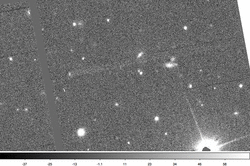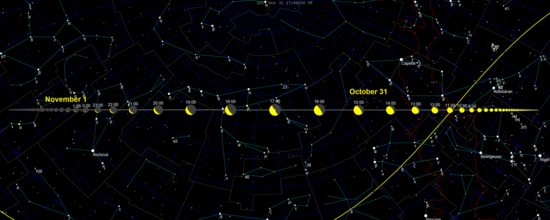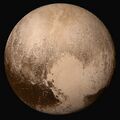Astronomy:2015 TB145
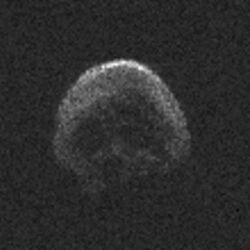 Radar image of 2015 TB145 taken by the Arecibo Observatory on 30 October 2015. | |
| Discovery[1] | |
|---|---|
| Discovered by | Pan-STARRS |
| Discovery date | 10 October 2015 |
| Designations | |
| 2015 TB145 | |
| Minor planet category |
|
| Orbital characteristics[2] | |
| Epoch 31 May 2020 (JD 2459000.5) | |
| Uncertainty parameter 0 | |
| Observation arc | 3.11 yr (1,137 d) |
| |{{{apsis}}}|helion}} | 3.9073 AU |
| |{{{apsis}}}|helion}} | 0.2941 AU |
| 2.1007 AU | |
| Eccentricity | 0.86002 |
| Orbital period | 3.04 yr (1,112.1 d) |
| Mean anomaly | 121.744° |
| Mean motion | 0° 19m 25.364s / day |
| Inclination | 39.6899° |
| Longitude of ascending node | 37.698° |
| 121.744° | |
| Earth MOID | 0.00295731 AU (442,407 km) |
| Jupiter MOID | 2.41052 AU |
| TJupiter | 2.97 |
| Physical characteristics | |
| Dimensions | |
| Rotation period | |
| Geometric albedo | 0.06[5] |
| Absolute magnitude (H) | 20.0[2][6] |
2015 TB145 is a sub-kilometer asteroid, classified as near-Earth object and potentially hazardous asteroid of the Apollo group, approximately 650 meters (2,000 feet) in diameter.[3] It safely passed 1.27 lunar distances from Earth on 31 October 2015 at 17:01 UTC,[7] and passed by Earth again in November 2018.
Discovery
The asteroid was first observed on 10 October 2015 by Pan-STARRS at an apparent magnitude of 20 using a 1.8-meter (71 in) Ritchey–Chrétien telescope.[1][6][lower-alpha 1] The asteroid was not discovered sooner because it spends most of its time beyond the orbit of Mars, has a large orbital inclination, and is usually well below the plane of the ecliptic.[9] The asteroid last passed within 0.064 astronomical unit|AU (9,600,000 km; 5,900,000 mi) of Earth on 29 October 1923 and will not pass that close again until 1 November 2088.[7]
The media has nicknamed the asteroid the "Great Pumpkin"[10] after the animated Halloween television special It's the Great Pumpkin, Charlie Brown,[11] "Spooky",[12] the "Halloween Asteroid",[13][14] and the "Skull Asteroid"[11] due to its skull-like appearance following radio frequency images taken at Arecibo Observatory and closest approach coincidentally occurring on Halloween day.[11]
2015 flyby
On 31 October 2015 the asteroid passed 0.00191 astronomical unit|AU (286,000 km; 178,000 mi) from the Moon and then passed 0.00325 AU (486,000 km; 302,000 mi) from Earth.[7]
The last approach this close by an object with absolute magnitude brighter than 20 was 2004 XP14 on 3 July 2006 at 1.1 lunar distances. The next object this large known to pass this close to Earth is (137108) 1999 AN10 that will pass about 1 lunar distance from Earth on 7 August 2027.[15] It is estimated that there are about 2400 near-Earth asteroids 300–500 meters in diameter, of which about 1100 have been discovered.[16]
During closest approach to Earth the asteroid reached about apparent magnitude 10,[17] which is much too faint to be seen by the naked eye. Even at peak brightness, the asteroid was a challenging target for amateur astronomers with small telescopes, best seen in the Northern hemisphere. The glare from an 80% waning gibbous Moon also hindered observations.[citation needed]
At 11:00 UT the asteroid was in the constellation of Taurus about 9 degrees from the Moon and moving at a rate of 3.4 degrees per hour.[17] At the time of closest approach of 17:00 UT the asteroid was in the constellation of Ursa Major about 56 degrees from the Moon and moving at a rate of 14.7 degrees per hour.[17] After closest approach it quickly became too faint and too close to the Sun in the sky to be seen.[15]
2018 flyby
After it had been unobservable for almost three years, 2015 TB145 was recovered on 7 October 2018 by L. Buzzi at Schiaparelli Observatory (observatory code 204), at apparent magnitude 21.[18]
The 11 November 2018 flyby was about 0.267 astronomical unit|AU (39,900,000 km; 24,800,000 mi) from Earth.[7][19]
Observations
Radar imagery
The close approach was studied with radar using Goldstone, the Green Bank Telescope,[15] and the Arecibo Observatory. It was one of the best radar targets of the year with a resolution as high as 2 meters (7 ft) per pixel.[15] Bistatic radar images created with the Green Bank Telescope had a resolution of 4 meters (13 ft) per pixel.[20] Arecibo images had a resolution of 7.5 meters (25 ft) per pixel.[5]
| 30 October | 31 October 12:55–13:08 UTC |
1 November |
|---|---|---|
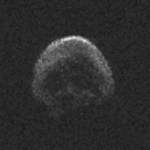
|
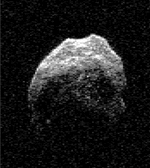
|
File:2015TB145 November 1.webm |
Possible cometary origin
The high orbital inclination and eccentricity suggest 2015 TB145 may be an extinct comet that has shed its volatiles after numerous passes around the Sun.[5][21] Orbital calculations by Petrus Jenniskens and Jérémie Vaubaillon showed that it was not expected to produce associated meteors in 2015.[22] Any meteoroids were expected to pass more than 0.0007 AU (100,000 km; 65,000 mi) from Earth's orbit.[22]
If meteoroids related to this asteroid were to cross Earth's path, the radiant is expected to be near Northern Eridanus.[22] Cameras for Allsky Meteor Surveillance (CAMS) did not detect any activity in the presumed area of the sky during 2013 and 2014.[22] The object has a low albedo of 0.06, which is only slightly more than a typical comet that has an albedo of 0.03-0.05.[5]
Notes
References
- ↑ 1.0 1.1 "MPEC 2015-T86: 2015 TB145". IAU Minor Planet Center. 2015-10-13. http://www.minorplanetcenter.net/mpec/K15/K15T86.html. (K15TE5B)
- ↑ 2.0 2.1 2.2 2.3 "JPL Small-Body Database Browser: (2015 TB145)". Jet Propulsion Laboratory. https://ssd.jpl.nasa.gov/sbdb.cgi?sstr=3729835.
- ↑ 3.0 3.1 Müller, T. G.; Marciniak, A.; Butkiewicz-Bąk, M.; Duffard, R.; Oszkiewicz, D.; Käufl, H. U.; Szakáts, R.; Santana-Ros, T. et al. (February 2017). "Large Halloween asteroid at lunar distance". Astronomy & Astrophysics 598: A63. doi:10.1051/0004-6361/201629584. Bibcode: 2017A&A...598A..63M. https://www.aanda.org/articles/aa/pdf/2017/02/aa29584-16.pdf. Retrieved 13 October 2018.
- ↑ "Asteroid Size Estimator". CNEOS NASA/JPL. https://cneos.jpl.nasa.gov/tools/ast_size_est.html.
- ↑ 5.0 5.1 5.2 5.3 5.4 5.5 Halloween Skies to Include Dead Comet Flyby. NASA-JPL press release. 30 October 2015
- ↑ 6.0 6.1 "2015 TB145 Orbit". IAU Minor Planet Center. http://www.minorplanetcenter.net/db_search/show_object?object_id=2015+TB145.
- ↑ 7.0 7.1 7.2 7.3 "JPL Close-Approach Data: (2015 TB145)". https://ssd.jpl.nasa.gov/sbdb.cgi?sstr=2015TB145;cad=1#cad.
- ↑ "2015TB145 Ephemerides for October 2012". NEODyS (Near Earth Objects – Dynamic Site). http://newton.spacedys.com/neodys/index.php?pc=1.1.3.1&n=2015TB145&oc=500&y0=2012&m0=10&d0=1&h0=0&mi0=0&y1=2012&m1=10&d1=15&h1=17&mi1=36&ti=1.0&tiu=days.
- ↑ Kelly Beatty (2015-10-22). "Close-in Asteroid Offers Halloween Treat". Sky & Telescope. http://www.skyandtelescope.com/astronomy-news/observing-news/close-in-asteroid-halloween-treat-102220155/.
- ↑ Sarah Begley (30 October 2015). "NASA Says 'Great Pumpkin' Asteroid Will Fly by on Halloween". TIME Magazine. http://time.com/4094227/nasa-great-pumpkin-asteroid/.
- ↑ 11.0 11.1 11.2 Nick Divito (31 October 2015). "Spooky 'skull asteroid' whizzes past Earth on Halloween". New York Post. https://nypost.com/2015/10/31/spooky-skull-asteroid-whizzes-past-earth-on-halloween/.
- ↑ Andrew Fazekas (23 October 2015). "Asteroid Called 'Spooky' Will Buzz Earth on Halloween". National Geographic Society. http://news.nationalgeographic.com/2015/10/151023-astronomy-asteroid-encounter-Earth-stargazing-nasa/.
- ↑ Koren, Marina (31 October 2015). "A Halloween Comet". The Atlantic. https://www.theatlantic.com/science/archive/2015/10/its-dead/413518/.
- ↑ ESA (28 October 2015). "Halloween Asteroid Gives us a Miss, Confirms ESA". European Space Agency. http://www.esa.int/Our_Activities/Operations/Space_Situational_Awareness/Halloween_asteroid_gives_us_a_miss_confirms_ESA.
- ↑ 15.0 15.1 15.2 15.3 Lance A. M. Benner (24 October 2015). "Goldstone Radar Observations Planning: 2009 FD and 2015 TB145". NASA/JPL Asteroid Radar Research. http://echo.jpl.nasa.gov/asteroids/2009FD/2009FD_planning.html.
- ↑ "WISE Revises Numbers of Asteroids Near Earth". NASA/JPL. 2011-09-29. http://www.nasa.gov/mission_pages/WISE/multimedia/gallery/neowise/pia14734.html. (NASA Space Telescope Finds Fewer Asteroids Near Earth)
- ↑ 17.0 17.1 17.2 "2015TB145 Ephemerides for 15 October 2015 through 31 October 2015". NEODyS (Near Earth Objects – Dynamic Site). http://newton.spacedys.com/neodys/index.php?pc=1.1.3.1&n=2015TB145&oc=500&y0=2015&m0=10&d0=15&h0=0&mi0=0&y1=2015&m1=11&d1=1&h1=0&mi1=0&ti=1.0&tiu=hours.
- ↑ "MPEC 2018-T130: 2015 TB145". Minor Planet Center. 10 October 2018. https://minorplanetcenter.net/mpec/K18/K18TD0.html.
- ↑ Williams, Matt (1 October 2018). "The "Death Comet" Will Pass By Earth Just After Halloween". Universe Today. https://www.universetoday.com/140108/the-death-comet-will-pass-by-earth-just-after-halloween/.
- ↑ "PIA20043: Halloween Asteroid Rotation". NASA/JPL-Caltech/GSSR/NRAO/GB. 2015-11-03. http://photojournal.jpl.nasa.gov/catalog/PIA20043.
- ↑ Agle, D. C. (21 October 2015). "NASA Spots the 'Great Pumpkin': Halloween Asteroid a Treat for Radar Astronomers". NASA News. http://www.jpl.nasa.gov/news/news.php?feature=4745.
- ↑ 22.0 22.1 22.2 22.3 "Possible October 31 Meteors From Minor Planet 2015 TB_145". SETI Institute. 2015-10-26. http://www.seti.org/seti-institute/news/possible-october-31-meteors-minor-planet-2015-tb145. (CBET 4154)
External links
- ALERT! Bright NEO 2015 TB145 on 29–31 October 2015 – Ian Musgrave (itelescope)
- WebCite archive of JPL solution #2 from 14 October 2015
- Halloween Asteroid is a Radar Science Treat (NASA Jet Propulsion Laboratory on YouTube)
- Halloween Asteroid 2015 TB145 Flyby Jerry Hilburn, 10/31/2015 12:12-12:24AM, Catfish Observatory, Teirra Del Sol, Canon 5D and an Orion ED 80 Refractor on an AVX Celestron Mount
- 2015 TB145 at NeoDyS-2, Near Earth Objects—Dynamic Site
- Ephemeris · Obs prediction · Orbital info · MOID · Proper elements · Obs info · Close · Physical info · NEOCC
- 2015 TB145 at ESA–space situational awareness
- 2015 TB145 at the JPL Small-Body Database
 |
